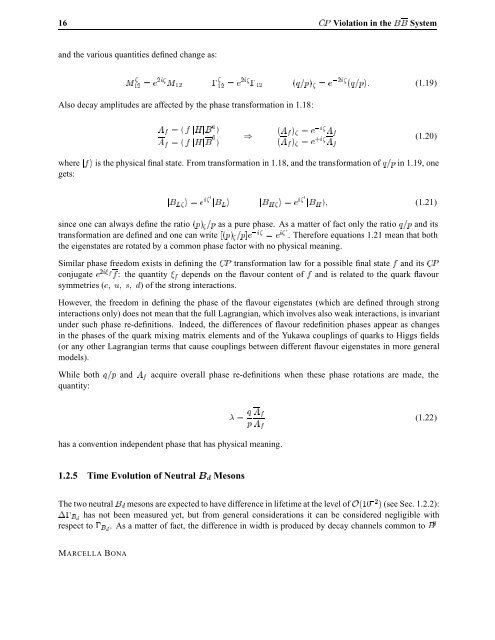Violation in Mixing
Violation in Mixing
Violation in Mixing
Create successful ePaper yourself
Turn your PDF publications into a flip-book with our unique Google optimized e-Paper software.
16 �È <strong>Violation</strong> <strong>in</strong> the �� System<br />
and the various quantities def<strong>in</strong>ed change as:<br />
Å � � � �� Å � � � �� Õ�Ô � � � �� Õ�Ô � (1.19)<br />
Also decay amplitudes are affected by the phase transformation <strong>in</strong> 1.18:<br />
�� � � � �À�� �<br />
�� � � � �À�� �<br />
�� � � � �� ��<br />
�� � � � �� ��<br />
(1.20)<br />
where ��� is the physical f<strong>in</strong>al state. From transformation <strong>in</strong> 1.18, and the transformation of Õ�Ô <strong>in</strong> 1.19, one<br />
gets:<br />
��Ä�� � � �� ��Ä� ��À�� � � �� ��À�� (1.21)<br />
s<strong>in</strong>ce one can always def<strong>in</strong>e the ratio Ô ��Ô as a pure phase. As a matter of fact only the ratio Õ�Ô and its<br />
transformation are def<strong>in</strong>ed and one can write � Ô ��Ô℄� �� � � �� . Therefore equations 1.21 mean that both<br />
the eigenstates are rotated by a common phase factor with no physical mean<strong>in</strong>g.<br />
Similar phase freedom exists <strong>in</strong> def<strong>in</strong><strong>in</strong>g the �È transformation law for a possible f<strong>in</strong>al state � and its �È<br />
conjugate � ��� �: the quantity �� depends on the flavour content of � and is related to the quark flavour<br />
symmetries ( � � � �) of the strong <strong>in</strong>teractions.<br />
However, the freedom <strong>in</strong> def<strong>in</strong><strong>in</strong>g the phase of the flavour eigenstates (which are def<strong>in</strong>ed through strong<br />
<strong>in</strong>teractions only) does not mean that the full Lagrangian, which <strong>in</strong>volves also weak <strong>in</strong>teractions, is <strong>in</strong>variant<br />
under such phase re-def<strong>in</strong>itions. Indeed, the differences of flavour redef<strong>in</strong>ition phases appear as changes<br />
<strong>in</strong> the phases of the quark mix<strong>in</strong>g matrix elements and of the Yukawa coupl<strong>in</strong>gs of quarks to Higgs fields<br />
(or any other Lagrangian terms that cause coupl<strong>in</strong>gs between different flavour eigenstates <strong>in</strong> more general<br />
models).<br />
While both Õ�Ô and �� acquire overall phase re-def<strong>in</strong>itions when these phase rotations are made, the<br />
quantity:<br />
� � Õ<br />
Ô<br />
has a convention <strong>in</strong>dependent phase that has physical mean<strong>in</strong>g.<br />
1.2.5 Time Evolution of Neutral � � Mesons<br />
��<br />
��<br />
(1.22)<br />
The two neutral �� mesons are expected to have difference <strong>in</strong> lifetime at the level of Ç (see Sec. 1.2.2):<br />
¡ �� has not been measured yet, but from general considerations it can be considered negligible with<br />
respect to �� . As a matter of fact, the difference <strong>in</strong> width is produced by decay channels common to �<br />
MARCELLA BONA















